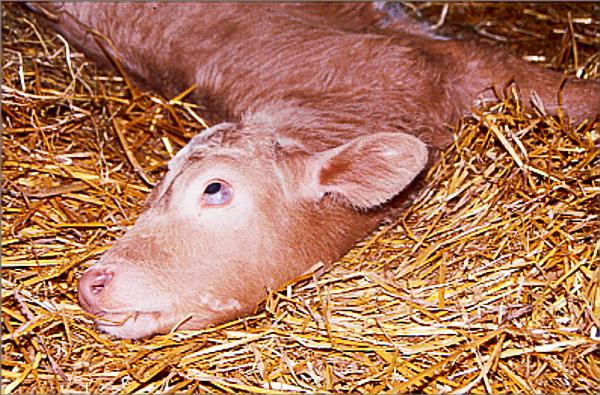When discussing meningitis in cattle, it is best to consider the two most common presentations:
- Septic meningitis in the neonatal calf
- Listeriosis, which is a common meningoencephalitis (inflammation of both the meninges and brain) in adult cattle.
Neonatal calf
Meningitis in the neonatal calf is almost always a sequel to septicaemia; i.e. bacteria and their toxins travel in the bloodstream and settle out in the blood vessels of the meninges leading to disease.
Calf septicaemia much more commonly leads to joint ill following the spread of bacteria from the navel or intestines.
However, in a small percentage of cases, meningitis ensues.
In most cases, the bacteria involved are those that are also associated with calf diarrhoea, i.e. E coli and Salmonella dublin. The most common predisposing factor for septicaemia and meningitis in calves is poor colostral management, i.e. failure of passive transfer of immunoglobulins (protective antibodies against infections).
Calves are basically born with a very under-developed immune system and are very dependent on the cow's colostrum to give them that initial immunity.
If calves do not take in sufficient good quality colostrum within the first six hours after birth, their ability to combat infection, in the form of diarrhoea, pneumonia or septicaemia is dramatically reduced.
Similarly, calves with meningitis that have not had passive transfer of immunoglobulins are unlikely to respond to treatment.
Symptoms
The clinical symptoms of bacterial meningitis depend on the stage of infection. Initially, calves tend to be depressed and have a high temperature. These signs rapidly progress to more classic signs associated with inflammation and fluid build-up (oedema) around the brain; i.e. rigidity of the neck, blindness, hyperaesthesia (nervousness/twitchiness), opisthotonus (head bent back with the eyes looking upwards - `star gazing' - Figure 1), and occasionally convulsions or coma.
Other signs that may be seen can be attributed to general septicaemia; e.g. joint ill, navel ill, diarrhoea, uveitis (inflammation of the pupil of the eye) and hypopyon (pus in the front chamber of the eye - Figure 2)
Many of these symptoms are not very commonly seen and would be difficult for a farmer to recognise, and so the diagnosis of meningitis requires a thorough veterinary examination.
Treatment
When advanced clinical signs are present, treatment is often unrewarding, unfortunately. The brain is very sensitive to inflammation and brain damage often occurs quite quickly.
Early veterinary treatment with broad-spectrum antibiotics (e.g. potentiated penicillins such as amoxicillin; cephalosporins; aminoglycosides, etc) will give the best chance of recovery.
These must be combined with anti-inflammatories to reduce the fluid build-up around the brain.
B vitamins can help to reduce brain damage and supportive care is very important, including soft, dry bedding and the administration of oral or intravenous fluids as necessary.
Control/Prevention
The key to preventing neonatal meningitis and neonatal septicaemia is good colostral management and good hygiene in the calf housing. In other words, the calf will be much less likely to get sick if he/she has a strong immune system (colostral antibodies) and if the calf is not exposed to as much pathogenic bacteria (hygienic calving area, good calf housing, adequate dipping of the navel). In terms of colostrum, the calf should receive three to four litres of colostrum in the first six hours after birth, followed by a similar volume in the next 12 to 18 hours.
One of the main portals of entry of bacteria into the calf's bloodstream after birth is via the navel. The navel should, therefore, be dipped with a concentrated iodine solution (or a chlorhexidine-based dip or oxytetracycline spray) at least twice: once immediately after birth and again 12 hours later.
*This article was previously published in the Irish farmers Journal on 5 November 2011 as part of a series on animal health.






 This is a subscriber-only article
This is a subscriber-only article











SHARING OPTIONS: